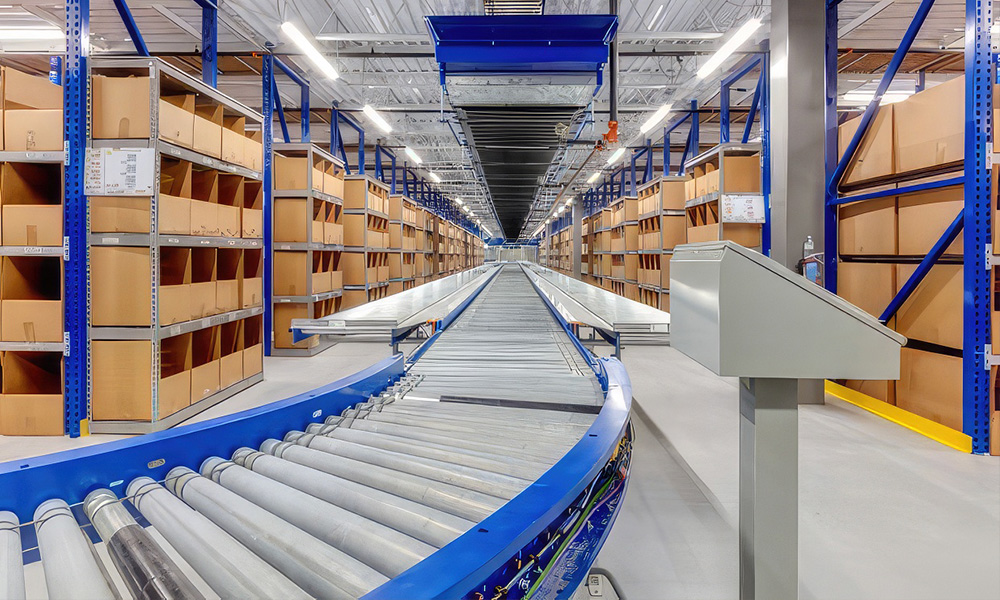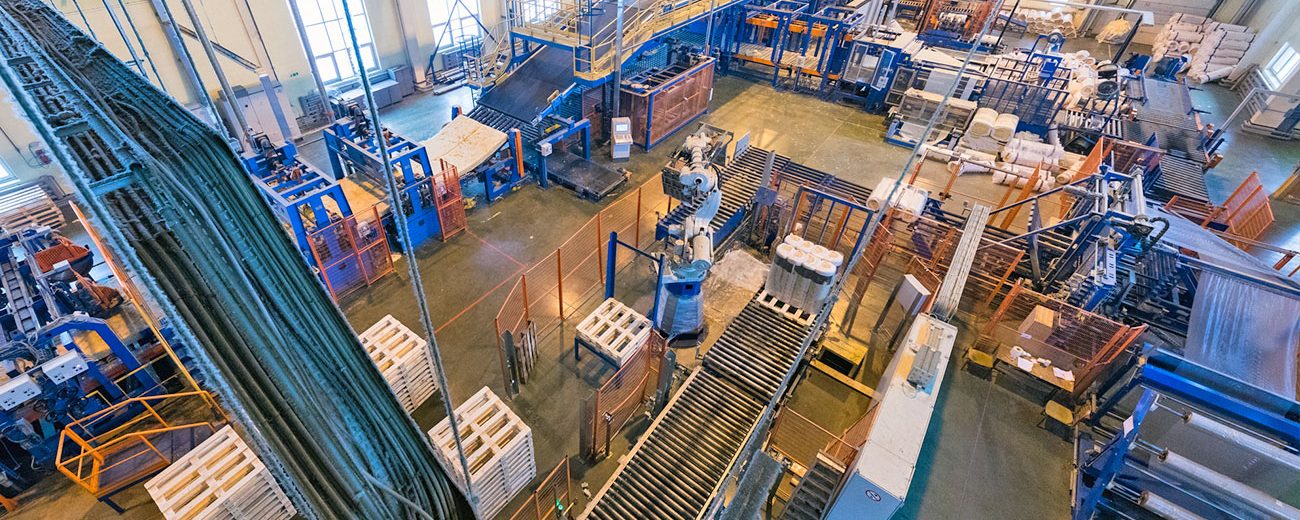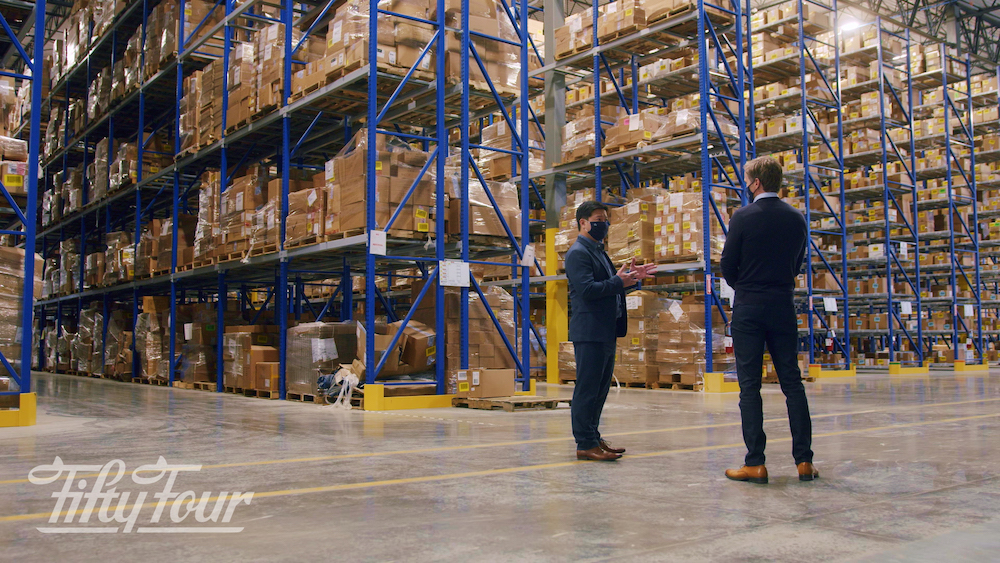
One of the most important features in running an efficient automated warehouse is the conveyor system. Today, functioning efficiently with maximum productivity is a necessity in all warehouses in a variety of industries. A top-quality conveyor system suited to specific warehouse requirements can improve the return on investment by producing a streamlined point-to-point operation. From transportation to sorting, palletizing to loading and unloading, conveyor system technologies replace manual processes and create a consistent and organized operational flow. There are several advantages to utilizing a conveyor system in any type of warehouse.
Some of those advantages include: increased operational productivity; improved workplace safety; diminished worker injuries; optimized space usage; enhanced logistical efficiency; controlled manual labor cost; and expanded flexibility in material handling. Conveyors have evolved along with most warehouse processes. Consideration of each type of conveyor system and how it functions within a particular automated warehouse environment is important. With the rapid growth in some industries, all components of a conveyor system must be evaluated for function as well as reliability before implementing. It is important to maintain a forward-thinking approach to expanding business, exceeding a return on investment and ensuring customer satisfaction.
Let’s expand on the reasons for taking advantage of conveyor systems.

Increased Operational Productivity
In a fast-paced warehouse or distribution center environment, moving product is a key function to meeting deadlines, guaranteeing a successful bottom line and enhancing customer satisfaction. With conveyors running continuously, faster processing and faster delivery is accomplished. There are multiple types of conveyors to select from: Gravity Roller Conveyors; Powered Belt Conveyors; Skatewheel Conveyors; Powered Roller Conveyors; Extendable Conveyors; Special Purpose Conveyors; Overhead Conveyors; Pipe Handling Conveyors; Sortation Conveyors; and Air-Lift Conveyor Systems. Depending on the industry, conveyors functioning in a commercial or industrial warehouse have the capability to prepare containers and parts; move raw materials; sort, batch and transfer inventory to processing zones; and facilitate manual and robotic quality checks for bulk goods. All of these functions ensure greater productivity and increased customer and employee satisfaction.
Improved Workplace Safety
In many warehouse environments, products are moving quickly and systems are running at full capacity. And if those products are heavy or hazardous or extremely fragile, then ensuring a safe warehouse floor is crucial. Maintaining a well-run conveyor system that has safety features such as stop buttons and barriers will assist in eliminating warehouse floor accidents. The possibility of experiencing downtime and destruction of product can be eased with a fully-functioning conveyor system. The selection of the appropriate system for each warehouse, distribution center and industry must be taken into consideration to avoid unfortunate setbacks in production. And as in all instances, the advantages can ensure productivity and efficiency which is one of the goals for a successful business.
Diminished Worker Injuries
Worker safety must be a top priority in any warehouse or distribution center. Use of conveyor systems will assist in minimizing injuries related to the movement of heavy goods, hazardous materials, and fragile products. Conveyors will replace the manual labor of lifting and transporting materials. During production, manual material handling can cause injuries such as physical strain and muscle tears. In some unfortunate situations, workers can suffer from cuts to their skin as well as bone breaks in arms or legs. Reducing the need for manual material handling can potentially increase productivity and diminish injuries that may be incurred by workers. Additional benefits include a reduction in workplace insurance claims and a promoting of goodwill toward workers. If the workers feel safe, then their attitude will improve and their work will reflect consistency and effectiveness toward the success of the business.

Optimized Space Usage
To operate a successful warehouse or distribution center, utilization of space is a key consideration in planning. Optimum usage of available space ensures a stream-lined process for all areas of the operation, from the warehouse floor to the administrative offices. Conveyor systems maximize floor space by using less footage than a manual work process where multiple rows on the warehouse floor are needed for workers to move, sort and package products. With that extra space, more materials can be processed at any given time, which also eliminates the need for additional storage space. With conveyor systems, each decision-maker has the choice of vertical and/or horizontal material handling. Since space is a large cost factor in purchasing, outfitting and operating a warehouse business or distribution center, integrating conveyors could result in realizing extra space that could be used for other operations or even expansion of the business.
Enhanced Logistical Efficiency
Consistency and efficiency are invaluable in manufacturing and warehouse businesses. Always looking to the bottom line and return on investment, all solutions must be analyzed and selected for optimal performance. Conveyors should be selected for the maximum benefit of material handling. Depending upon the type of specific tasks that are conducted, the processes of moving, handling, packaging, and loading product down the assembly line should be flexible, consistent and fast. Utilizing conveyor systems will eliminate manual movement and handling throughout the operation. With the appropriate configuration for a particular type of warehouse, a conveyor system can reduce handling time and minimize the occurrence of errors, leading to a smoother handling and packaging process.
Controlled Manual Labor Cost
Another advantage of utilizing conveyor systems in a warehouse or distribution environment is the increased capability to control labor costs. An effective, smooth-running conveyor can decrease the need for manual labor, allowing those workers to accomplish other tasks in the warehouse. Even though safety measures are put in place and adhered to, there is always the possibility of an accident that will cause expenses for the business and the worker. With a more controlled process that the conveyor system offers, situations that cause downtime, accidents, and destruction of materials can be reduced. And of course, that will lead to decreased costs and an excellent return on investment.

Material Handling Flexibility
The versatility of conveyors in moving product is excellent. The systems can be designed to accommodate a multitude of product types and sizes. At any given time, that flexibility is important when there are changes in customer needs or a change in the market. The point-to-point line movement can adjust to the latest requirements with little downtime and maximum efficiency. Adding a conveyor to any packaging process is a resourceful and bold move for aligning a business toward a successful future. Forward-thinking processes and procedures in a warehouse can make a difference in productivity.
And yes, there are many advantages of implementing a conveyor system in a warehouse or distribution center. From worker safety to increased productivity and efficiency to meeting business goals, conveyor systems can be extremely helpful in automating a warehouse or distribution center.
Varieties of Conveyor Systems
As stated previously, there are a number of conveyor systems available in today’s market. From simple to machine-fed, the choices are numerous. Most types of conveyors can be power-driven or manually-driven, and are described as gravity conveyors. Gravity Roller Conveyors are good for uneven, open, or rimmed bottom packages that are heavy. Skatewheel Conveyors are economical and can be used effectively in loading trucks while easily moving packages. Each type can be configured to straight or curved lines. There is the option of Powered Roller Conveyors which will bend around corners and obstacles and can move products longer distances. There is also the option for belt conveyors which have a solid surface that can offer more flexibility in positioning. With Powered Belt Conveyors the lines are straight but will handle irregular-shaped products easily, avoiding product damage.
There are also Special Purpose Conveyors that handle more specialized loads. An Air-Lift Conveyor System is typically a vertical pneumatic system that transports materials overhead in a closed component offering a clean environment and low maintenance. This system moves larger volumes of product over longer distances. Pipe Handling Conveyors transport pipes and tubes on concave or bowtie rollers, ensuring that the product stays in the center of the conveyor to avoid damage. Overhead Conveyors offer a unique means for transporting heavy or light loads. These conveyors leverage unused vertical space and save valuable floor space for other operations. They are sometimes called hanging, monorail or overhead transport conveyors. This is a highly flexible solution for conveying product if the warehouse has tall ceilings. Sortation Conveyors can switch loads from one conveyor line to another at varying speeds. These are sometimes used for smaller orders and on-demand e-commerce operations.
Trust 54 Intralogistics For Selection Of A Conveyor System
54 Intralogistics can help determine which type of conveyor system a particular automated warehouse or distribution center needs. Our experts are knowledgeable in all aspects of warehouse automation and will provide the advantages and disadvantages of each conveyor system for any industry’s material handling processes. Traditional linear conveyors may lack flexibility for productions where processes operate at different speeds or in multiple flow paths. Some can fit in smaller locations within the warehouse and some can handle additional actions in the point-to-point process. As stated above in the descriptions of the various conveyor systems, the options are endless.
Contact us today to learn more about the options for obtaining and integrating the best conveyor system to meet all warehouse process goals and demands.
